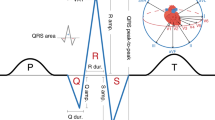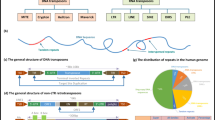Abstract
The sequence of the highly polymorphic region near the human insulin gene, which begins 363 base pairs before the start of transcription and extends upstream, indicated that it is generated by variation in the number and arrangement of members of a family of tandemly repeating nucleotides whose structure is related to ACAGGGGTGTGGGG. Another 15-base pair sequence, repeated twice near the human gene, is located ∼325 base pairs on either side of the polymorphic region. One member is in the transcriptional control region.
This is a preview of subscription content, access via your institution
Access options
Subscribe to this journal
Receive 51 print issues and online access
$199.00 per year
only $3.90 per issue
Buy this article
- Purchase on Springer Link
- Instant access to full article PDF
Prices may be subject to local taxes which are calculated during checkout
Similar content being viewed by others
References
Bell, G. I. et al. Nature 284, 26–32 (1980).
Bell, G. I., Pictet, R. L. & Rutter, W. J. Nucleic Acids Res. 8, 4091–4109 (1980).
Owerbach, D., Bell, G. I., Rutter, W. J. & Shows, T. B. Nature 286, 82–84 (1980).
Owerbach, D., Bell, G. I., Rutter, W. J., Brown, J. A. & Shows, T. B. Diabetes 30, 267–270 (1981).
Ullrich, A., Dull, J. J., Gray, A., Brosius, J. & Sures, I. Science 209, 612–615 (1980).
Bell, G. I., Karam, J. H. & Rutter, W. J. Proc. natn. Acad. Sci. U,S.A. 78, 5759–5763 (1981).
Wyman, A. R. & White, R. Proc. natn. Acad. Sci. U.S.A. 77, 6754–6758 (1980).
Corden, J. et al. Science 209, 1406–1414 (1980).
Efstratiadis, A. et al. Cell 21, 653–668 (1980).
Wu, C. & Gilbert, W. Proc. natn. Acad. Sci. U.S.A. 78, 1577–1580 (1981).
Lomedico, P. et al. Cell 18, 545–558 (1979).
Klobutcher, L. A., Swanton, M. T., Donini, P. & Prescott, D. M. Proc. natn. Acad. Sci. U.S.A. 78, 3015–3019 (1981).
Katzen, A. L., Cann, G. M. & Blackburn, E. H. Cell 24, 313–320 (1981).
Benoist, C. & Chambon, P. Nature 290, 304–310 (1981).
Gruss, P., Dhar, R. & Khoury, G. Proc. natn. Acad. Sci. U.S.A. 78, 943–947 (1981).
Fedoroff, N. Cell 16, 697–710 (1979).
Nikaido, T., Nakai, S. & Honjo, T. Nature 292, 845–848 (1981).
Brutlag, D. L. A. Rev. Genet. 14, 121–144 (1980).
Streeck, R. E. Science 213, 443–445 (1981).
Smith, G. P. Science 191, 528–535 (1976).
Slightom, J. L., Blechl, A. E. & Smithies, O. Cell 21, 627–638 (1980).
Sures, I., Lowry, J. & Kedes, L. H. Cell 15, 1033–1044 (1978).
Humbel, R. E., Bosshard, H. R. & Zahn, H. in Handbook of Physiology Sect.7, Vol. 1 (eds Steiner, D. F. & Freinkel, N. 111–132 (American Physiological Society, Washington DC), 1972).
Harper, M. E., Ullrich, A. & Saunders, G. F. Proc. natn. Acad. Sci. U.S.A. 78, 4458–4460 (1981).
Botstein, D., White, R. L., Skolnick, M. & Davis, R. W. Am. J. hum. Genet. 32, 314–331 (1980).
Maxam, A. M. & Gilbert, W. Meth. Enzym. 65, 499–560 (1980).
Cooke, N. E., Coit, D., Shine, J., Baxter, J. D. & Martial, J. A. J. biol. Chem. 256, 4007–4016 (1981).
Cordell, B. et al. Cell 18, 533–543 (1979).
Author information
Authors and Affiliations
Rights and permissions
About this article
Cite this article
Bell, G., Selby, M. & Rutter, W. The highly polymorphic region near the human insulin gene is composed of simple tandemly repeating sequences. Nature 295, 31–35 (1982). https://doi.org/10.1038/295031a0
Received:
Accepted:
Issue Date:
DOI: https://doi.org/10.1038/295031a0
This article is cited by
-
A brief insight into the etiology, genetics, and immunology of polycystic ovarian syndrome (PCOS)
Journal of Assisted Reproduction and Genetics (2022)
-
The multi-faceted functioning portrait of LRF/ZBTB7A
Human Genomics (2019)
-
Association of genetic variants in INS (rs689), INSR (rs1799816) and PP1G.G (rs1799999) with type 2 diabetes (T2D): a case–control study in three ethnic groups from North-West India
Molecular Genetics and Genomics (2016)
-
Role of the 5-HTTLPR and SNP Promoter Polymorphisms on Serotonin Transporter Gene Expression: a Closer Look at Genetic Architecture and In Vitro Functional Studies of Common and Uncommon Allelic Variants
Molecular Neurobiology (2016)
-
ESI Mass Spectrometric Exploration of Selective Recognition of G-Quadruplex in c-myb Oncogene Promoter Using a Novel Flexible Cyclic Polyamide
Journal of the American Society for Mass Spectrometry (2014)
Comments
By submitting a comment you agree to abide by our Terms and Community Guidelines. If you find something abusive or that does not comply with our terms or guidelines please flag it as inappropriate.



